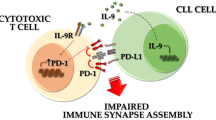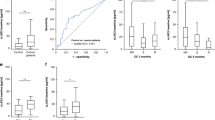Abstract
In this study, we show that high serum levels of soluble human leukocyte antigens (HLA) class I molecules (sHLA-I, range: 0.7–1.7 μg/ml) and soluble Fas ligand (FasL, range: 0.4–1.9 ng/ml) are detected in patients with acute myeloid leukemia (AML) at diagnosis, compared with healthy donors (HD) (sHLA-I, range: 0.1–0.6 μg/ml; sFasL, range: 0.1–0.4 ng/ml). Patients' sera were able to induce transcription and secretion of FasL in CD8+ T cells, followed by apoptosis in vitro; this apoptosis was inhibited by anti-HLA-I-specific monoclonal antibodies, suggesting that sHLA-I is responsible for cell death. These findings closely relate to the in vivo upregulation of FasL transcription observed in peripheral blood (PB) lymphocytes from AML patients; in the same cells, mRNA for the antiapoptotic proteins Bcl-2 and Bcl-xL was downregulated. Interestingly, caspase-8 and caspase-3, both downstream mediators of death receptor-induced apoptosis, were activated in CD8+ cells of AML patients; one-third of these cells were already apoptotic in vivo, at variance with lymphocytes of HD. These data strongly suggest that in AML, increased levels of sHLA-I molecules may contribute to the elimination of potentially anti-tumor effector cells through a FasL/Fas interaction.
This is a preview of subscription content, access via your institution
Access options
Subscribe to this journal
Receive 12 print issues and online access
$259.00 per year
only $21.58 per issue
Buy this article
- Purchase on Springer Link
- Instant access to full article PDF
Prices may be subject to local taxes which are calculated during checkout





Similar content being viewed by others
References
Zavazava N . Soluble HLA class I molecules: biological significance and clinical implications. Mol Med Today 1998; 3: 116–121.
Bjorkman P, Saper MA, Samraoui B, Bennett WS, Strominger JL, Wiley DC . Structure of the human class I histocompatibility antigen HLAβ-A2. Nature 1987; 329: 506–512.
Charlton RK, Zmijewski CM . Soluble HL-A7 antigen: localization in the β-lipoprotein fraction of human serum. Science 1997; 170: 636–637.
van Rood J, van Leeuwen A, van Santen M . Anti HL-A2 inhibitor in normal human serum. Nature 1970; 226: 366–367.
Grumet F . Report of the Second International Soluble HLA (sHLA) Workshop. Hum Immunol 1994; 40: 153–165.
Puppo F, Scudelletti M, Indiveri F, Ferrone S . Serum HLA class I antigens: markers and modulators of an immune response? Immunol Today 1995; 16: 124–127.
Zavazava N, Bottcher H, Mueller-Ruchholtz WM . Soluble MHC class I antigens (sHLA) and anti-HLA antibodies in heart and kidney allograft recipients. Tissue Antigens 1993; 42: 20–26.
De Vito-Haynes LD, Jankowska-Gan E, Sollinger HW, Knechtle SJ, Burlingham WJ . Monitoring of kidney and simultaneous pancreas-kidney transplantation rejection by release of donr-specific soluble HLA class I. Hum Immunol 1994; 40: 191–202.
Mathew JM, Shenoy S, Phelan D, Lowell J, Howard T, Mohanakumar T . Biochemical and immunological evaluation of donor specific soluble HLA in the circulation of liver transplan recipients. Transplantation 1996; 62: 217–223.
Shimura T, Hagihara M, Yamamoto K, Takebebe K, Munkhbat B, Ogoshi K et al. Quantification of serum-soluble HLA class I antigens in patients with gastric cancer. Hum Immunol 1994; 40: 183–186.
Shimura T, Tsutsumi S, Hosouchi Y, Kojima T, Ton Y, Yonezu M et al. Clinical significance of soluble form of HLA class I molecule in Japanese patients with pancreatic cancer. Hum Immunol 2001; 62: 615–619.
Westhoff U, Fox C, Otto FJ . Soluble HLA class I antigens in plasma of patients with malignant melanoma. Anticancer Res 1998; 18: 3789–3792.
Nocito M, Montalban C, Gonzalez-Porque P, Villar LM . Increased soluble serum HLA class I antigens in patients with lymphoma. Hum Immunol 1997; 58: 106–111.
Elliot T, Heisen H . Allorecognition of purified major histocompatibility complex glycoproteins by cytotoxic T lymphocytes. Proc Natl Acad Sci USA 1988; 85: 2728–2732.
Kane K, Sherman L, Mescher M . Molecular interactions required for triggering alloantigen-specific cytolytic T lymphocytes. J Immunol 1989; 142: 4153–4160.
Hausmann R, Zavazava N, Steinmann J, Mueller-Ruchholtz WM . Interaction of papain-digested HLA class I molecules with human alloreactive cytotoxic T lymphocytes (CTL). Clin Exp Immunol 1993; 91: 183–188.
Carbone E, Terrazzano G, Colonna M, Tosto L, Piccolella E, Franksson L et al. Natural killer clones recognize specific soluble HLA class I molecules. Eur J Immunol 1996; 26: 683–689.
Spaggiari GM, Contini P, Carosio R, Arvigo M, Ghio M, Oddone D et al. Soluble HLA class I molecules induce natural killer cell apoptosis through the engagement of CD8: evidence for a negative regulation exerted by members of the inhibitory receptor superfamily. Blood 2002; 99: 1706–1714.
Spaggiari GM, Contini P, Dondero A, Carosio R, Puppo F, Indiveri F et al. HLA class I induces NK cell apoptosis upon the engagement of killer-activationg HLA class I receptors through FasL-Fas interaction. Blood 2002; 100: 4098–4107.
Zavazava N, Kronke M . Soluble HLA class I molecules induce apoptosis in alloreactive cytotoxic T lymphocytes. Nat Med 1996; 2: 1005–1010.
Puppo F, Contini P, Ghio M, Brenci S, Scudelletti M, Filaci G et al. Soluble human MHC class I molecules induce soluble Fas ligand secretion and trigger apoptosis in activated CD8+ Fas (CD95)+ T lymphocytes. Int Immunol 1999; 12: 195–203.
Salter RD, Benjamin RJ, Wesley PK, Buxton SE, Garrett TP, Clayberger C et al. A binding site for the T-cell co-receptor CD8 on the α3 domain of HLA-A2. Nature 1990; 345: 41–46.
Contini P, Ghio M, Merlo A, Poggi A, Indiveri F, Puppo F . Apoptosis of antigen-specific T lymphocytes upon the engagement of CD8 by soluble HLA class I molecules is Fas ligand/Fas mediated: evidence for the involvement of p56lck, calcium calmodulin kinase II, and calcium-independent protein kinase C signalling pathways and for NF-kB and NF-AT nuclear translocation. J Immunol 2005; 175: 7244–7254.
Ferrero E, Belloni D, Contini P, Foglieni C, Ferrero ME, Fabbri M et al. Transendothelial migration leads to protection from starvation-induced apoptosis in CD34+ CD14+ circulating precursors: evidence for PECAM-1 involvement through Akt/PKB activation. Blood 2003; 101: 186–193.
Chao DT, Korsmeyer SJ . Bcl-2 family: regulators of cell death. Annu Rev Immunol 1998; 16: 395–419.
Barnhart BC, Alappat EC, Peter ME . The CD95 type I/typeII model. Semin Immunol 2003; 15: 185–193.
Thorburn A . Death receptor-induced cell killing. Cell Signal 2004; 16: 139–144.
Calne R, Davies H . Organ graft tolerance: the liver effect. Lancet 1994; 343: 67–68.
Rebmann V, Regel J, Stolke D, Grosse-Wilde H . Secretion of sHLA-G molecules in malignancies. Semin Cancer Biol 2003; 13: 371–377.
Wiendl H, Mitsdoerffer M, Hofmeister V, Wishhusen J, Bornemann A, Meyermann R et al. A functional role of HLA-G expression in humen gliomas: an alternative strategy of immune escape. J Immunol 2002; 168: 4772–4780.
Doubrovina ES, Doubrovin MM, Vider E, Sisson RB, O'Reilly RJ, Dupont B et al. Evasion from NK cell immunity by MHC class I chain-related molecules expressing colon adencarcinoma. J Immunol 2003; 171: 6891–6899.
Zhang L, Fang B . Mechanisms of resistance to TRAIL-induced apoptosis in cancer. Cancer Gene Ther 2005; 12: 228–237.
Andreeff M, Jiang S, Zhang X, Konopleva M, Estrov Z, Snell VE et al. Expression of Bcl-2-related genes in normal and AML progenitors: changes induced by chemotherapy and retinoic acid. Leukemia 1999; 13: 1881–1892.
Konopleva M, Zhao S, Hu W, Jiang S, Snell V, Weidner D et al. The anti-apoptotic genes Bcl-X(L) and Bcl-2 are over-expressed and contribute to chemoresistance of non-proliferating leukemic CD34+ cells. Br J Haematol 2002; 118: 521–534.
Sonneveld P, Nooter K . Reversal of drug-resistance by cyclosporin-A in a patient with acute myelocytic leukaemia. Br J Haematol 1990; 75: 208–211.
Ross DD, Wooten PJ, Sridara R, Ordonez JV, Lee EJ, Schiffer CA . Enhancement of daunorubicin accumulation, retention and cytotoxicity, by verapamil or cyclosporin A in blast cells from patients with previously untreated acute myeloid leukaemia. Blood 1993; 82: 1288–1299.
Tsimberidou A, Estey E, Cortes J, Thomas D, Faderl S, Verstovsek S et al. Gemtuzumab, fludarabine, cytarabine and cyclosporine in patients with newly diagnosed acute myelogenous leukemia or high-risk myelodisplastic syndromes. Cancer 2003; 97: 1481–1487.
Acknowledgements
This work was partially supported by CIPE (IMM-03) and by the Italian Association for Cancer Research (to AP and MRZ).
Author information
Authors and Affiliations
Corresponding author
Rights and permissions
About this article
Cite this article
Contini, P., Zocchi, M., Pierri, I. et al. In vivo apoptosis of CD8+ lymphocytes in acute myeloid leukemia patients: involvement of soluble HLA-I and Fas ligand. Leukemia 21, 253–260 (2007). https://doi.org/10.1038/sj.leu.2404494
Received:
Revised:
Accepted:
Published:
Issue Date:
DOI: https://doi.org/10.1038/sj.leu.2404494



